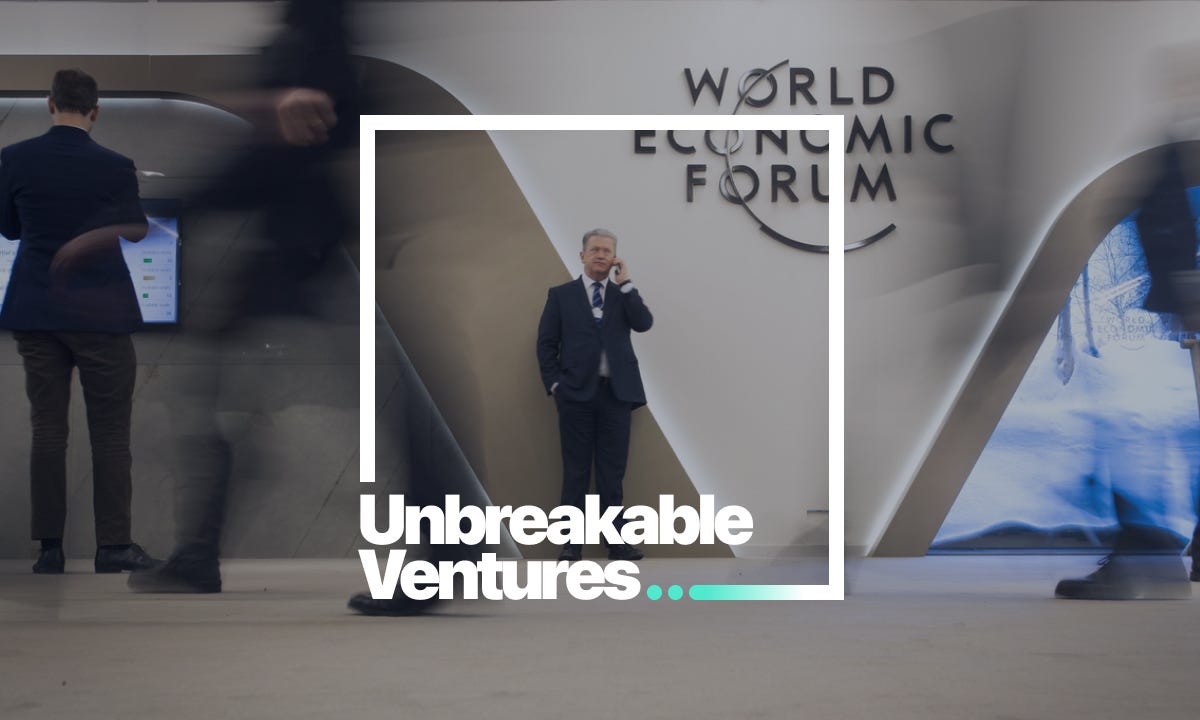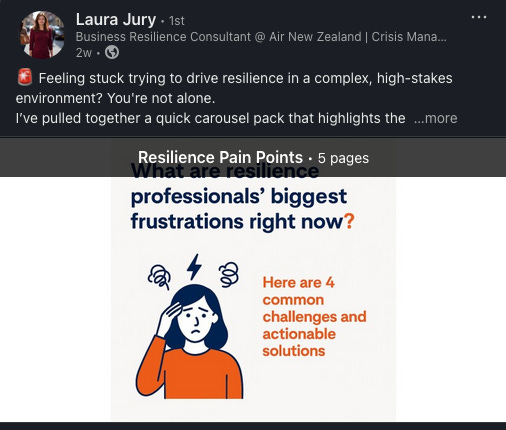The Resilience skills you will need by 2030
And how a global Airline's Business Continuity pro + the World Economic Forum's 'Future of Jobs' report can help you start today.
Written for Unbreakable Ventures by Guest Contributor, Laura Jury
We’re often told the solution to mitigating the disruptions of the threat landscape is resilience; a word thrown around like it’s a finished product, available to all, and a one-stop solution.
All you need is a shiny plan, a training module, a polished framework and the job is done. Except, that’s not how it works in the 21st century.
Resilience isn’t a state you reach when the checklist is ticked, or a one-and-done thing. Resilience is a muscle, and like any muscle, if you don’t use it, test it, and stretch it, it weakens.
True resilience embodies mindset, culture, and constant evolution. If you’ve worked in this space long enough like I have, you know that no two days are the same.
So when the World Economic Forum dropped its Future of Jobs Report 2025 in January, it was a call to action for all of us in this industry to take note. A reminder that we don’t get to stand still in this game - complacent with the same skills we’ve referred to throughout the decades.
The skills that define resilience leaders in 2030
That’s only 5 years away, and given the increasing, volatile risks that evolve every day, we need to be building those skills now.
My take is that these are not theoretical skills. These are the core capabilities that already underpin the best resilience professionals out there, and they demand deliberate effort to build and demonstrate.
So, how do you keep yourself future-fit for this VUCA (volatile, uncertain, complex, ambiguous) world? And, let’s be honest, how do you make sure people see it?
Analytical & Systems Thinking: The Muscle to See the Whole Board
Resilient individuals don’t just solve the problem in front of them. They step back, see the systemic impacts, the shifting parts, and the dependencies no one else is watching. It’s not a one-off project to them, they show up like this every time.
For three back-to-back reports now, WEF have stated Analytical Thinking as the top skill.
But, to me, the real work starts with actions like scenario mapping; thinking not just about the what ifs, but the so whats. It’s about practising second- and third-order thinking. Mapping out those ripple effects - visually and being comfortable with messy drafts and visualisations that just get it on the board.
Reiterate and confirm confidence in yourself by posting or visualising your thinking. Share frameworks, post-mortems, or exercise reflections that show how you think across systems. This does three things: It shows how you solve the risk (as a reminder for later), shows how you have connected the dots others miss, and can be used as a support for others and reiteration of your capabilities (if that’s relevant to you).
Resilience, Flexibility & Agility: Make It Visible
The only constant is change.
Every good resilience professional knows this. Supply chain today, cyber breach tomorrow, and leadership confusion the day after that.
Flexibility and agility aren’t optional, they’re survival traits. But I’ve seen many during high pressure situations struggle to maintain this. Specifically, the large number of crisis management teams activated for months on end during the covid-19 pandemic - a truly exhausting period.
One effective technique is to document how you’ve pivoted under pressure. Talk about the real-world shifts, the unexpected, the lessons learned. That’s how we build credibility externally. It’s not about pretending everything went smoothly; it’s about showing how you adapted when it didn’t.
If you’re not sharing those stories you’re missing the chance to lead the narrative.
Leadership & Social Influence: Lead Outside the Org Chart
True leadership is about influence, not titles. Resilience professionals rarely sit at the top of the org chart, but they drive the outcomes that matter. But understanding how to build influence can create or concentrate the culture of resilience we need in our workplaces.
To build influence, there are a few concepts that tend to work. Making your way into employee networks (diversity, wellbeing, sustainability) where you can shape discussions outside your silo.
Join industry bodies and volunteer. The ISRM AKL Chapter (yes, that’s a plug from me) is looking for committee leaders right now. Could this be the leap you needed to stand up, show up, and get more involved?
Also, it’s OK to step outside your job description. Be the person who pulls people together. And again, show it. Post about the collaborative projects, the cross-functional wins, the relationships built across silos. People need to see your leadership, not just hear about it.
Motivation & Self-Awareness: The Fuel That Keeps You Standing
You will be well aware that this world doesn’t slow down. Neither does the pressure as the risk landscape flywheel picks up momentum. If you’re not clear on what fuels you, you’ll burn out long before the next disruption ignites.
Self-awareness isn’t soft—it’s a leadership lever. You must know your why, what impact do you want to have? You must prioritise energy management, not just time. Know when you do your best work (I’m a morning strategist - don’t ask me for deep work at 3 PM).
Make sure to celebrate wins, even the small ones. Share them. Make them visible.
Externally post about how you stay resilient (like through a newsletter like this or even in a LinkedIn post). Show your human side. People don’t really follow brands any more and they certainly don’t follow resilience plans, they follow resilient people.
Creative Thinking: Challenge the Play-book
To drive this home, you need to remember that what worked yesterday won’t cut it tomorrow. The threat landscape is changing too fast: climate, cyber, AI, geopolitics.
Creativity isn’t about being artistic; it’s about asking: What’s possible now that wasn’t before?
When you really think about this, you will find tools available to you never once an option (GenAI for example, or the ability to work from anywhere). So, invite challenge. Bring people from outside resilience into your problem-solving. Ask yourself:
What am I missing?
But, make sure to always provide space for friction. That’s where the best ideas come from.
Showcase this skill by sharing new approaches to old risks. Post about experiments, what worked, what didn’t. Let people see how you think differently.
{image of Laura’s LinkedIn}
These are the exact competency traits the WEF are talking about, critical come 2030.
Curiosity & Lifelong Learning: Stay Ahead of the Curve
Curiosity is the antidote to irrelevance.
If you’re not learning, you’re falling behind.
I block 30 minutes a week for curiosity-driven learning. Micro-courses, podcasts, webinars, whatever keeps the resilience muscle sharp. Anyone can - and should - do this.
As Mortimer Adler said: "The person who says he knows what he thinks but cannot express it usually does not know what he thinks." Feynman embodied this idea in practice.
According to Richard Feynman in a Farnam Street article, Feynman’s technique was to understand the true essence of something rather than merely knowing its name, then get it to a conversational level a 12-year old would understand.
Sharing what you’re learning externally is a powerful way to place an understanding deep into your subconscious. Post about courses you’ve taken or insights you’ve gained and invite conversation. Show that you’re not just keeping pace, you’re staying ahead.
Time to act
WEF’s 2030 skills are a warning of the future skills we will require to remain truly resilient. But we must act on these today.
2030 is closer than you might think, and the workforce will demand that resilience leaders evolve. Don’t wait for the world to change. Change with it.
What’s your growth edge? Which of these skills are you building right now? Drop it in the comments, I want to hear what’s driving your learning journey.
Let’s keep building a resilience community that’s truly unbreakable.
Unbreakable Ventures welcomes Guest Writer, Laura Jury.
We’re thrilled to welcome Laura to Unbreakable Ventures as our first guest contributor. Laura brings sharp insight, real-world lessons, and bold perspectives on corporate risk, resilience, crisis, and emergency management making her perfect for the message we aim to share.
Laura is a subject matter expert in Business Continuity and Crisis Management, currently leading the development of an advanced Business Continuity Framework for Air New Zealand. With a career spanning high-stakes environments—particularly aviation and financial services—Laura’s work focuses on helping organisations move beyond box-ticking exercises to build practical, adaptable, and enduring resilience. Whether navigating cyber threats, pandemic responses, or executive-level crisis decisions, her approach is grounded, strategic, and people-first (which strongly follows the values of Unbreakable Ventures).
Her career includes senior roles at ASB Bank and other major institutions, where she has led the response to some of the most significant operational disruptions in recent memory. Laura operates comfortably in a VUCA world (volatile, uncertain, complex, ambiguous), using her deep expertise to ensure businesses can stand tall when the unexpected happens.
You can follow and connect with Laura on LinkedIn here
On Writing—and the Role of AI in the Process
Laura uses GenAI to support her writing process, including research, exploring context, grammar, and shaping article frameworks. All content is personally reviewed and reflects her own views and experience—not those of her employers.
“Quick insight into my content creation process: I'm passionate about AI and have integrated it into my writing on Business Resilience, Business Continuity, and Crisis Management. While editing isn't my strongest suit, AI helps enhance clarity and coherence. I always personally review, update, and edit to ensure authenticity. My posts reflect my thoughts, not my employers' BC or Crisis programs. Privacy is a priority—sensitive info is anonymised and adheres to industry policies.
The ideas? They’re mine. The experience? Hard-earned. The tone and message? Personally reviewed every time.
Encouraging More Voices in Risk and Resilience
Laura’s mission is to share what she knows and inspire others to do the same.
If you're a professional in risk, resilience, or crisis leadership, she urges you to speak up. Don’t wait for the perfect sentence. Use the tools available, build your voice, and contribute to the collective wisdom of this field.
Laura will be contributing regularly to Unbreakable Ventures, sharing practical insights, challenging conventional thinking, and exploring how we can all evolve alongside a rapidly shifting threat landscape.
Because, as she reminds us, resilience isn’t a destination—it’s a journey. And we’re excited to have her on this one with us.








